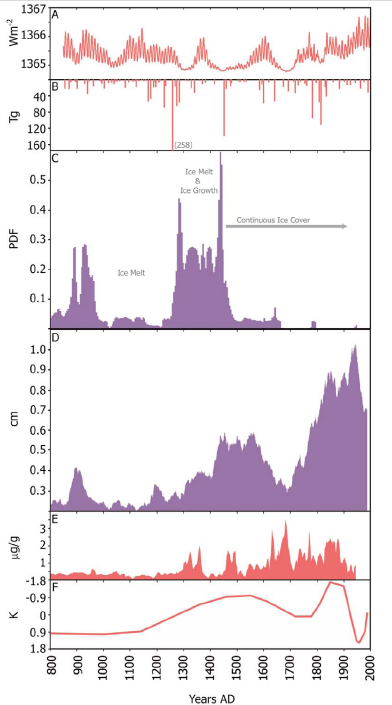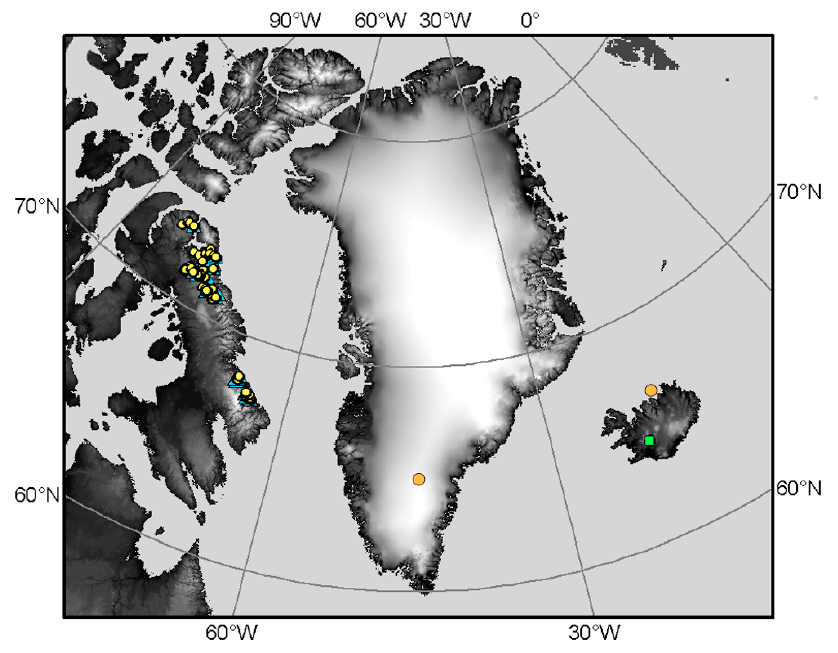Volcanic Influence on the Little Ice Age
Posted on 8 February 2012 by dana1981
The causes and even start and duration of the Little Ice Age (LIA), a global cooling event of approximately 0.5°C over several centuries ending in the late 19th Century, has been a challenge for climate scientists to pin down, with many possible contributing factors. A very interesting new paper by Miller et al. (2012) seeks to answer these questions by simulating the climate response to a number of large volcanic eruptions during the LIA timeframe. As the authors note, the challenge lies not only in determining the cause of the LIA, but when the event even started:
"...the natural radiative forcings are either weak or, in the case of explosive volcanism, shortlived [Robock, 2000], thus requiring substantial internal feedback. The LIA is particularly enigmatic. Despite extensive historical documentation and a wide array of proxy records that define climate change during the past millennium [Mann et al., 2008], there is no clear consensus on the timing, duration, or controlling mechanisms of the LIA."
A similar paper, Anderson et al. (2008), was previously discussed here.
The Data
Miller et al. used precisely-dated records of ice-cap growth from Arctic Canada and Iceland in their attempt to assess the timing and duration of the LIA. The ice caps exhibit little or no flow, and thus preserve rooted tundra vegetation that was alive at the time of ice-cap expansion. This enabled the scientists to use carbon dating on the vegetation. This process accurately dates the time when snowline dropped below the vegetation altitude, killing the plants, and remained on average below that site until the summer warmth of recent decades. The locations from which Miller et al. gathered vegetation samples are illustrated in Figure 1.
Figure 1: Arctic Canada sites with recently exposed entombed plants dated younger than 800 AD (circles) and older than 800 AD (triangles); Hvítárvatn, Iceland (square); Greenland temperature borehole site and sea ice record on the North Iceland shelf (round).
LIA Begins
The Miller et al. probability distribution function (PDF) and large number of vegetation klll dates toward the end of the 13th Century suggest that the LIA may have been triggered at this time, which is generally earlier than the LIA was previously thought to have begun.
"Discrete peaks in the composite PDF define widespread abrupt summer cooling events that resulted in a persistent snowline depression, allowing the expansion of ice caps over sites that did not subsequently become ice-free until the most recent decade. The cluster of kill-dates between 1275 and 1300 AD, following 300 years with few kill dates, defines an abrupt summer temperature decrease in the late 13th Century."
Figure 2, particularly frames b and c, illustrate the ice-cap growth at the end of the 13th Century, coinciding with an increase in atmospheric aerosols due to a period of high volcanic activity caused by four closely-spaced volcanic eruptions.
"The PDF [probability distribution function] peak defining abrupt LIA cooling 1275–1300 AD coincides with an interval of four large stratospheric sulfur loadings from explosive volcanism following a multi-centennial warm interval, during which complete revegetation of deglaciated sites would have fully reset the radiocarbon clock (Figure 2c)."

Figure 2: (a) Total solar irradiance (VSK [Schmidt et al., 2011]). (b) Global stratospheric sulfate aerosol loadings [Gao et al., 2008]. (c) Ice cap expansion dates based on a composite of 94 Arctic Canada calibrated 14C PDFs. (d) 30-year running mean varve thickness in Hvítárvatn sediment core HVT03-2 [Larsen et al., 2011]. (e) Arctic Ocean sea ice recorded in a sediment core on the north Iceland shelf [Massé et al., 2008]; heavy sea ice years correlate with anomalously cold summers across Iceland. (f) Temperature anomalies over southern Greenland (wrt 1881–1980 AD mean) from the borehole temperature inversion at DYE-3 [Dahl-Jensen et al., 1998].
The peaks shown in Figure 2c define widespread abrupt summer cooling events that resulted in a persistent snowline depression, allowing the expansion of ice caps over sites that did not subsequently become ice-free until recent years.
Feedbacks
A difficulty in attributing the LIA cooling to volcanic eruptions is that aerosols have a short residence time in the atmosphere, generally being washed out after just a year or two. If spaced relatively close together, volcanic eruptions can have a cooling effect over the span of a few decades, but the LIA was a much longer event.
"Decadally paced eruptions may produce greater cooling than a single large eruption if the recurrence interval is shorter than the upper ocean temperature relaxation time of decades [Schneider et al., 2009]. This may explain multidecadal cold episodes, but many Canadian sites that became ice-covered ~1275 AD and ~1450 AD, following episodes of strong explosive volcanism, remained continuously ice-covered until the most recent decade (Figure 2c)."
Thus in order to explain a long-term cooling like the LIA, the volcanic eruptions must trigger certain feedback effects in order to extend their impact on the climate. Miller et al. ran transient climate model simulations and believe they have identified some of these possible feedbacks.
First, the reduced incoming solar radiation due to the volcanic aerosols blocking sunlight allowed Arctic ice to expand. The Arctic ice expansion increases the overall reflectivity (albedo) of the Earth, causing it to cool further. The increase in Arctic sea ice in the north Atlantic Ocean also bring more cold and fresh water to the region, impacting the ocean circulation.
"...increased southward sea ice export following the eruptions led to freshening and vertical stratification of the North Atlantic subpolar gyre, reducing open ocean convection and thus weakening the Atlantic meridional overturning circulation."
Miller et al. concluded that these feedbacks were sufficient to sustain a LIA cooling for centuries. Their theory is supported by reconstructions of sea ice around Iceland, where sea ice does not form, and only appears when there is a large export of sea ice from the Arctic Ocean.
"Sea ice was rarely present on the North Iceland shelf from 800 AD until the late 13th Century, when an abrupt rise in sea-ice proxies suggests a rapid increase in Arctic Ocean sea ice export, followed by another increase ~1450 AD, after which sea ice was continuously present until the 20th Century [Massé et al., 2008] (Figures 1 and 2e). The increase in sea ice north of Iceland at the start of the LIA, and its persistence throughout the LIA, supports our modeling experiments suggesting explosive volcanism and associated feedbacks resulted in a self-sustaining expanded sea-ice state beginning 1275–1300 AD."
Summary
Miller et al. suggest that a period of anomalously high volcanic activity at the end of the 13th Century could have triggered Arctic sea ice and ocean circulation feedbacks sufficient to cause the centuries-long cooling associated with the LIA. The authors conclude by noting that while the decline in solar activity associated with the Maunder Minimum in the 17th Century contributed to the LIA cooling, a decline in solar irradiance is not necessary to explain the initial triggering of the LIA cooling.
"The coincidence of repeated explosive volcanism with centuries of lower-than-modern solar irradiance (Figure 2a) [Schmidt et al., 2011] indicates that volcanic impacts were likely reinforced by external forcing [Mann et al., 2009], but that an explanation of the LIA does not require a solar trigger."
However, it's also worth noting that it took four closely-spaced large volcanic eruptions to trigger these feedbacks and LIA cooling. In most cases, the effects of volcanic eruptions on the global temperature are limited to a timespan of a few years.
Additionally, while the data supporting the volcanic trigger of the LIA in the paper are fairly convincing, the modeling suggesting that the associated feedbacks are sufficient to sustain cold temperatures for several centuries is less conclusive. In another paper, Zhang et al. (2011), only two simulations out of four show the proposed feedback. In an interview with Science magainze regarding this paper, NASA climate scientist Gavin Schmidt agreed that too few model runs have been performed to conclusively demonstrate that the cooling feedbacks sustained the LIA by themselves.
"I think it is likely that the abrupt start to the Little Ice Age in the late 13th century is volcanic in origin...I'm far less convinced that this is the cause of the subsequent centuries of climate change."































 Arguments
Arguments
























 0
0  0
0 It sure looks like these coolings are short-lived transients.
It sure looks like these coolings are short-lived transients.
 Clearly these volcanic events were known; I'm still not seeing convincing evidence that they initiate cooling lasting hundreds of years.
Clearly these volcanic events were known; I'm still not seeing convincing evidence that they initiate cooling lasting hundreds of years.
 The upper curve is summer temperature from tree rings; the bottom curve is advance/retreat of the Great Aletsch glacier. At this level of resolution, the LIA splits into three mini-LIAs, making the 'recovering from LIA' meme even more of a stretch.
The upper curve is summer temperature from tree rings; the bottom curve is advance/retreat of the Great Aletsch glacier. At this level of resolution, the LIA splits into three mini-LIAs, making the 'recovering from LIA' meme even more of a stretch.







Comments